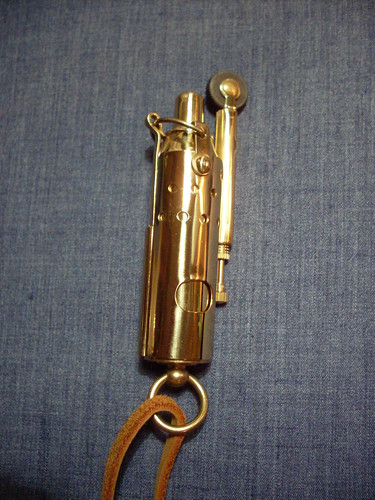This lighter by The New Method Company was made in the USA in the 1950s. It is a catalytic lighter that uses a tiny ball of platinum black which is suspended on fine wires in the igniter cap.
To use the lighter, you pull off the cap. You dip the igniter into the hollow wick tube. The platinum black reacts (oxidation) with the methanol fumes and heats the platinum wires, which in turn ignite the methanol fumes.
This lighter will run only on pure methanol. Methanol with additives fouls the platinum black. Heet in the yellow bottle works as fuel.
This type of lighter probably didn't catch on, because methanol fumes were very toxic, and because the flame was not very visible. You might set your beard on fire while trying to light up. Not that I wear a beard-unless I'm in disguise. I do like to burn things, though. Oops, said too much.

It's an interesting conversation piece for any pyromaniac. I will over time post videos showing some of my favorite lighters. Flickr will let me post only two videos per month, so you don't have to worry about eyestrain.

Short Video
To use the lighter, you pull off the cap. You dip the igniter into the hollow wick tube. The platinum black reacts (oxidation) with the methanol fumes and heats the platinum wires, which in turn ignite the methanol fumes.
This lighter will run only on pure methanol. Methanol with additives fouls the platinum black. Heet in the yellow bottle works as fuel.
This type of lighter probably didn't catch on, because methanol fumes were very toxic, and because the flame was not very visible. You might set your beard on fire while trying to light up. Not that I wear a beard-unless I'm in disguise. I do like to burn things, though. Oops, said too much.

It's an interesting conversation piece for any pyromaniac. I will over time post videos showing some of my favorite lighters. Flickr will let me post only two videos per month, so you don't have to worry about eyestrain.

Short Video



